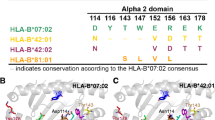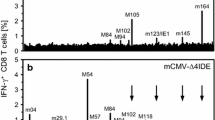Abstract
In order to investigate the role of residues inside and outside the peptide binding cleft of the L2 molecule in peptide presentation to cytotoxic T lymphocytes (CTL), we constructed a series of point mutations in the L d gene. We determined the effects of the mutations in the Ld molecule on the binding and recognition of an Ld-restricted CTL epitope derived from the nucleoprotein (NP) of the lymphocytic phoriomeningitis virus (LCMV). Each of the mutations within the Ld peptide binding cleft resulted in a complete loss of CTL recognition. Addition of the LCMV NP peptide to cells expressing these mutants did not increase surface Ld expression, suggesting that the mutations altered peptide binding. Mutations involving pockets D and E within the cleft affected LCMV peptide binding and recognition as drastically as those in pocket B, which was predicted to interact with a main anchor residue of the peptide. In striking contrast, the mutations located outside the cleft did not change either recognition or binding. These results demonstrate that the Ld residues in the peptide binding cleft are the main determinants dictating LCMV NP peptide binding, and that the residues in each of the pockets within the cleft play a role in this interaction. Surprisingly, one mutation outside the peptide binding cleft, T92S, abrogated CTL lysis of target cells treated with the LCMV NP peptide, but not virus-infected cells. These data show that this mutation selectively altered the presentation of the LCMV NP peptide introduced to the cell exogenously, but not endogenously. This implies that the pathway by which peptides associate with class I molecules within the cell differs from that of exogenous peptide binding.
Similar content being viewed by others
References
Aichele, P., Hengartner, H., Zinkernagel, R. M., and Schulz, M. Antiviral cytotoxic T cell response induced by in vivo priming with a free synthetic peptide. J Exp Med 171: 1815, 1990
Bordo, D. and Argos, P. Suggestions for “safe” residue substitutions in site directed mutagenesis. J Mol Biol 217: 721, 1991
Buxton, S. E., Benjamin, R. J., Clayberger, C., Parham, P., and Krensky, A. M. Anchroing pockets in human histocompatibility complex leukocyte antigen (HLA) class I molecules: Analysis of the conserved B (“45”) pocket of HLA-B27. J Exp Med 175: 809, 1992
Carreno, B. M., Winter, C. C., Taurog, J. D., Hansen, T. H., and Biddison, W. E. Residues in pockets B and F of HLA-B27 are critical in the presentation of an influenza A virus nucleoprotein peptide and influence the stability of peptide-MHC complexes. Int Immunol 5: 353, 1993
Christinck, E. R., Luscher, M. A., Barber, B. H., and Williams, D. B. Peptide binding to class I MHC on living cells and quantitation of complexes required for CATL lysis. Nature 352: 67, 1991
Colbert, R. A., Rowland-Jones, S. L., McMichael, A. J., and Frelinger, J. A. Allele-specific B pocket transplant in class I major histocompatibilility complex protein changes requirement for anchor residue at P2 of peptide. Proc Natl Acad Sci USA 90: 6879, 1993
Corr, M., Boyd, L. F., Frankel, S. R., Kozlowski, S., Padlan, E. A., and Margulies, D. H. Endogenous peptides of a soluble major histocompatibility complex class I molecules. H-2Ld S: Sequence motif, quantitative binding, and molecular modeling of the complex. J Exp Med 176: 1681, 1992
Falk, K., Rötzschke, O., Stevanovic, S., Jung, G., and Rammensee, H.-G. Allele-specific motifs revealed by sequencing of self peptides eluted from MHC molecules. Nature 351: 290, 1991
Fremont, D. H., Matsumura, M., Stura, E. A., Peterson, P. A., and Wilson, I. A. Crystal structures of two viral peptides in complex with murine MHC class I H-2Kb. Science 257: 919, 1992
Gotch, F. M., Rothbard, J., Howland, K., Townsend, A. R. M., and McMichael, A. J. Cytotoxic T lymphocytes recognize a fragment of influenza virus matrix protein in association with HLA-A2. Nature 326: 881, 1987
Hunt, H. D., Pullen, J. K., Dick, R. F., Bluestone, J. A., and Pease, L. R. Structural basis of Kbm8 alloreactivity. Amino acid substitutions on the β-pleated floor of the antigen recognition site. J Immunol 145: 1456, 1990
Ishioka, G. Y., Colon, S., Miles, C., Grey, H. M., and Chesnut, R. W., Induction of class I MHC-restricted, peptide-specific cytolytic T lymphocytes by peptide priming in vivo. J Immunol 143: 1094, 1989
Jackson, M. R., Cohen-Doyle, M. F., Peterson, P. A., and Williams, D. B. Regulation of MHC Class I transport by the molecular chaperone, Calnexin (p88, IP90). Nature 263: 384, 1994
Jaulin, C., Romero, P., Luescher, I. F., Casanova, J. L., Prochnicka-Chalufour, A., Langlade-Demoyen, P., Maryanski, J. L., and Kourilsky, P. Most residues on the floor of the antigen binding site of the class I MHC molecule H-2Kd influence peptide presentation. Int Immunol 4: 943, 1992
Latron, F., Pazmany, L., Morrison, J., Moots, R., Saper, M. A., McMichael, A., and Strominger, J. L. A critical role for conserved residues in the cleft of HLA-A2 in presentation of a nonpeptide to T cells. Science 257: 964, 1992
Lie, W.-R., Myers, N. B., Gorka, J., Rubocki, R. J., Connolly, J. M., and Hansen, T. H. Peptide ligand-induced conformation and surface expression of the Ld class I MHC molecule. Nature 344: 439, 1990
Lurquin, C., Van Pel, A., Mariamé, B., De Plaen, E., Szikora, J.-P., Janssens, C., Reddehase, M. J., Lejeune, J., and Boon, T. Structure of the gene of tum− transplantation antigen P91A: the mutated exon encodes a peptide recognized with Ld by cytolytic T cells. Cell 58: 293, 1989
Madden, D. R., Garboczi, D. N., and Wiley, D. C. The antigenic identity of peptide-MHC complex: a comparison of the conformations of five viral peptides presented by HLA-A2. Cell 75: 693, 1993
Matsui, M., Hioe, C. E., and Frelinger, J. A. Roles of the six peptide-binding pockets of the HLA-A2 molecule in allorecognition by human cytotoxic T-cell clones. Proc Natl Acad Sci USA 90: 674, 1993
McKinney, D. M., Chen, P.-J., and McMillan, M. Single Dd amino acid substitutions in the H-2Ld molecule identify antibody epitopes. Immunogenetics 39: 440–443, 1994
McLaughlin, T. E., Miyada, C. G., McMillan, M., and Wallace, R. B. Direct demonstration of critical amino acid residues required for cytotoxic T-lymphocyte allorecognition of H-2 class I antigens. Proc Natl Acad Sci USA 85: 3085, 1988
McMichael, A. J., Gotch, F. M., Santos-Aguado, J., and Strominger, J. L. Effect of mutations and variations of HLA-A2 on recognition of a virus peptide epitope by cytotoxic T lymphocytes. Proc Natl Acad Sci USA 85: 9194, 1988
Muller, D., Pederson, K., Murray, R., and Frelinger, J. A. A single amino acid substitution in an MHC class I molecule allows heteroclitic recognition by lymphocytic choriomeningitis virus-specific cytotoxic T lymphocytes. J Immunol 147: 1392, 1991
Oldstone, M. B. A., Ahmed, R., Byrne, J., Buchmeier, M. J., Riviere, Y., and Southern, P. Virus and immune responses: lymphocytic choriomeningitis virus as prototype model of viral pathogenesis. Br Med Bull 41: 70, 1985
Rohren, E. M., Pease, L. R., Ploegh, H. L., and Schumacher, T. N. Polymorphisms in pockets of major histocompatibility complex class I molecules influence peptide preference. J Exp Med 177: 1713, 1993
Rötzschke, O., Falk, K., Deres, K., Schild, H., Norda, M., Metzger, J., Jung, G., and Rammensee, H.-G. Isolation and analysis of naturally processed viral peptides as recognized by cytotoxic T cells. Nature 348: 252, 1990
Ruppert, J., Sidney, J., Celis, E., Kubo, R. T., Grey, H. M., and Sette, A. Prominent role of secondary anchor residues in peptide binding to HLA-A2.1 molecules. Cell 74: 929, 1993
Saper, M. A., Bjorkman, P. J., and Wiley, D. C. Refined structure of the human histocompatibility antigen HLA-A2 at 2.6 Å resolution. J Mol Biol 219: 277, 1991
Schulz, M., Aichele, P., Vollenweide, M., Bobe, F. W, Cardinaux, F., Hengartner, H., and Zinkernagel, R. M. Major histocompatibility complex-dependent T cell epitopes of lympocytic choriomeningitis virus nucleoprotein and their protective capacity against viral disease. Eur J Immunol 19: 1657, 1989
Silver, M. L., Guo, H.-C., Strominger, J. L., and Wiley, D. C. Atomic structure of a human MHC molecule presenting an influenza virus peptide. Nature 360: 367, 1992
Smith, J. D., Lie, W.-R., Gorka, J., Kindle, C. S., Myers, N. B., and Hansen, T. H. Disparate interaction of peptide ligand with nascent versus mature class I major histocompatibility complex molecules: Comparisons of peptide binding to alternative forms of Ld in cell lysates and the cell surface. J Exp Med 175: 191, 1992
Townsend, A. R. M., Rothbard, J., Gotch, F. M., Bahadur, G., Wraith, D., and McMichael, A. J. The epitopes of influenza nucleoprotein recognized by cytotoxic T lymphocytes can be defined with short synthetic peptides. Cell 44: 929, 1986
Van Bleek, G. M. and Nathenson, S. G. Isolation of an endogenously processed immunodominant viral peptide from the class I H-2Kb molecule. Nature 348: 213, 1990
Villadangos, J. A., Galocha, B., Lopez, D., Calvo, V., and Lopez de Castro, J. A. Role of binding pockets for amino-terminal peptide residues in HLA-B-27 allorecognition. J Immunol 149: 505, 1992
Whitton, J. L., Gebhard, J. R., Lewicki, H., Tishon, A., and Oldstone, M. B. A. Molecular definition of a major cytotoxic T-lymphocyte epitope in the glycoprotein of lymphocytic choriomeningitis virus. J Virol 62: 687, 1988
Whitton, J. L., Tishon, A, Lewicki, H., Gebhard, J., Cook, T., Salvato, M., Joly,., and Oldstone, M. B. A. Molecular of a five-amino-acid cytotoxic T-lymphocyte (CTL) epitope: an immunodominant region which induces nonreciprocal CTL cross reactivity. J Virol 63: 10, 1989
Winter, C. C., Carreno, B. M., Turner, R. V., Koenig, S., and Biddison, W. E. The 45 pocket of HLA-A2.1 plays a role in presentation of influenza virus matric peptide and alloantigens. J Immunol 146: 3508, 1991
Wipke, B. T., Jameson, S. C., Bevan, M. J., and Pamer, E. G. Variable binding affinities of listeriolysin O peptides for the H-2Kd class I molecule. Eur J Immunol 23: 2005, 1993
Zhang, W., Young, A. C. M., Imarai, M., Nathenson, S. C., and Sachettini, J. C. Crystal structure of the major histocompatibility complex class I H-2Kb molecule containing a single viral peptide: implications for peptide binding and T-cell receptor recognition. Proc Natl Acad Sci USA 89: 8403, 1992
Whitton, J. L., Tishon, A., Lewicki, H., Gebhard, J., Cook, T., Salvato, M., Joly, E., and Oldstone, M. B. A. Molecular analyses of a five-amino-acid cytotoxic T-lymphocyte (CTL) epitope: an immunodominant region which induces nonreciprocal CTL cross reactivity. J Virol 63: 10, 1989
Winter, C. C., Carreno, B. M., Turner, R. V., Koenig, S., and Biddison, W. E. The 45 pocket of HLA-A2.1 plays a role in presentation of influenza virus matrix peptide and alloantigens. J Immunol 146: 3508, 1991
Wipke, B. T., Jameson, S. C., Bevan, M. J., and Pamer, E. G. Variable binding affinities of listeriolysin O peptides for the H-2Kd class I molecule. Eur J Immunol 23: 2005, 1993
Zhang, W., Young, A. C. M., Imarai, M., Nathenson, S. G., and Sacchettini, J. C. Crystal structure of the major histocompatibility complex class I H-2Kb molecule containing a single viral peptide: implications for peptide binding and T-cell receptor recognition. Proc Natl Acad Sci USA 89: 8403, 1992
Author information
Authors and Affiliations
Rights and permissions
About this article
Cite this article
Hioe, C.E., McKinney, D.M., Frelinger, J.A. et al. Mutations inside but not outside the peptide binding cleft of the H-2 Ld molecule affects CTL recognition and binding of the nucleoprotein peptide from the lymphocytic chroriomeningitis. Immunogenetics 40, 222–229 (1994). https://doi.org/10.1007/BF00167083
Received:
Issue Date:
DOI: https://doi.org/10.1007/BF00167083




